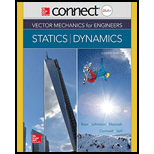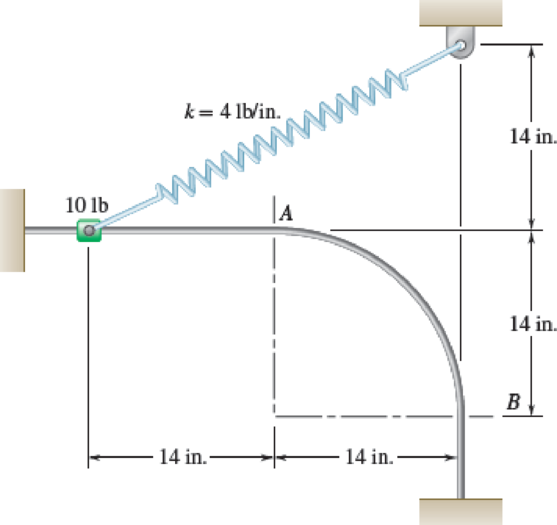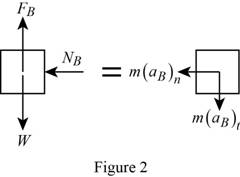
A 10-lb collar is attached to a spring and slides without friction along a fixed rod in a vertical plane. The spring has an undeformed length of 14 in. and a constant k = 4 lb/in. Knowing that the collar is released from rest in the position shown, determine the force exerted by the rod on the collar at (a) point A, (b) point B. Both these points are on the curved portion of the rod.
Fig. P13.73

(a)
Find the force exerted by the rod on the collar at A
Answer to Problem 13.73P
The force exerted by the rod on the collar at A
Explanation of Solution
Given information:
The weight of the collar (W) is
The un-deformed length
The spring constant (k) is
The length of top support to point A
The length of point A to point B
The horizontal distance from weight to point A
The horizontal distance from point A to point B
The acceleration due to gravity (g) is
Calculation:
Calculate the mass of the collar (m) using the relation:
Substitute
Consider the position 1.
Calculate the length from weight to point B
Substitute
Calculate the stretch in rod
Substitute
Here, the kinetic energy at position 1
Calculate the potential energy in the position 1 due to elongation of the rod
Substitute
Here, the potential energy in the position 1 due to gravitation of the rod
Calculate the total potential energy
Substitute
Consider the position A.
Calculate the length at point A
Substitute
Calculate the stretch in rod
Substitute
Calculate the kinetic energy at position A
Here,
Substitute
Calculate the potential energy in the position A due to elongation of the rod
Substitute
Here, the potential energy in the position 1 due to gravitation of the rod
Calculate the total potential energy
Substitute
The expression for principle for conservation of energy as follows;
Substitute 0 for
Show the free body diagram of the point A with the forces acting as in Figure (1).

Calculate the normal acceleration at position A
Substitute
Calculate the spring force at position A
Substitute
Calculate the angle
Substitute
Calculate the force exerted by the rod on the collar in the point A
Substitute
Therefore, the force exerted by the rod on the collar at A
(b)
Find the force exerted by the rod on the collar at B
Answer to Problem 13.73P
The force exerted by the rod on the collar at B
Explanation of Solution
Given information:
The weight of the collar (W) is
The un-deformed length
The spring constant (k) is
The length of top support to point A
The length of point A to point B
The horizontal distance from weight to point A
The horizontal distance from point A to point B
The acceleration due to gravity (g) is
Calculation:
Consider the position B.
Calculate the length at point B
Substitute
Calculate the stretch in rod
Substitute
Calculate the kinetic energy at position B
Here,
Substitute
Calculate the potential energy in the position B due to elongation of the rod
Substitute
Calculate the potential energy in the position B due to gravitation of the rod
Substitute
Calculate the total potential energy
Substitute
The expression for principle for conservation of energy as follows;
Substitute 0 for
Show the free body diagram of the point B with the forces acting as in Figure (2).

Calculate the normal acceleration at position b
Substitute
Calculate the spring force at position B
Substitute
Calculate the force exerted by the rod on the collar in the point B
Substitute
Therefore, the force exerted by the rod on the collar at B
Want to see more full solutions like this?
Chapter 13 Solutions
Connect 2 Semester Access Card for Vector Mechanics for Engineers: Statics and Dynamics
- Please answer this NEATLY, COMPLETELY, and CORRECTLY for an UPVOTE. In the system shown, a 150 N collar-pulley assembly slides on a horizontal shaft with coefficient of kinetic friction μk = 0.10 between the collar and the shaft, and is acted upon by a force P with a magnitude of P = 253.5 N at an angle θ = 30.35° as shown. Knowing that the assembly is initially at rest, what is the time when the velocity reaches to 3 m/s? Also, at this instant, find the tension in the cord and the velocity of block A.arrow_forwardA spring AB of constant k is attached to a support at A and to a collar of mass m. The unstretched length of the spring is 1 . Knowing that the collar is released from rest at x=x0 and neglecting friction between the collar and the horizontal rod, determine the magnitude of the velocity of the collar as it passes through point C.arrow_forwardA 1-kg block B is moving with a velocity v0 of magnitude v0 = 2 m/s as it hits the 0.5-kg sphere A , which is at rest and hanging from a cord attached at 0 . Knowing that μk= 0.6 between the block and the horizontal surface and e = 0.8 between the block and the sphere, determine after impact (a) the maximum height h reached by the sphere, (b) the distance x traveled by the block.arrow_forward
- Solve Prob. 13.68 assuming the kinetic coefficient of friction between the package and the incline is 0.2.Reference to Problem 13.68:A spring is used to stop a 50-kg package that is moving down a 20° incline. The spring has a constant k = 30 kN/m and is held by cables so that it is initially compressed 50 mm. Knowing that the velocity of the package is 2 m/s when it is 8 m from the spring and neglecting friction, determine the maximum additional deformation of the spring in bringing the package to rest.arrow_forwardMembers ABC has a mass of 2.4 kg and is attached to a pin support at B. An 800-g sphere D strikes the end of member ABC with a vertical velocity v1 of 3 m/s. Knowing that L = 750 mm and that the coefficient of restitution between the sphere and member ABC is 0.5, determine immediately after the impact (a) the angular velocity of member ABC (b) the velocity of the sphere.arrow_forwardThree spheres, each with a mass of m , can slide freely on a frictionless, horizontal surface. Spheres A and B are attached to an inextensible, inelastic cord with a length I and are at rest in the position shown when sphere B is struck squarely by sphere C , which is moving with a velocity v0 . Knowing that the cord is taut when sphere B is struck by sphere C and assuming perfectly elastic impact between B and C , and thus the conservation of energy for the entire system, determine the velocity of each sphere immediately after impact.arrow_forward
- A piston of mass m and cross-sectional area A is in equilibrium under the pressure p at the center of a cylinder closed at both ends. Assuming that the piston is moved to the left a distance a 2 and released, and knowing that the pressure on each side of the piston varies inversely with the volume, determine the velocity of the piston as it again reaches the center of the cylinder. Neglect friction between the piston and the cylinder and express your answer in terms of m, a, P and A.arrow_forwardA 5-kg collar A is at rest on top of, but not attached to, a spring with stiffness k1 = 400 N/m when a constant 150-N force is applied to the cable. Knowing A has a speed of 1 m/s when the upper spring is compressed 75 mm, determine the spring stiffness k2 . Ignore friction and the mass of the pulley.arrow_forwardSHOW COMPLETE SOLUTION A spring is used to stop 50kg block moving down a 20 degrees inclined plane. The spring has a constant K= 30KN/M and is held by the cables so that it is initially compressed 50mm. Knowing that the velocity of the package is 2m/s when it is 8m from the spring and assuming the kinetic coefficient of friction between the package and the incline is 0.20. Determine: A. Final kinetic energy B. Maximum additional deformation of spring in bringing the block to rest C. Frictional forcearrow_forward
- Two disks sliding on a frictionless horizontal plane with opposite velocities of the same magnitude v0 hit each other squarely. Disk A is known to have a weight of 6 lb and is observed to have zero velocity after impact. Determine (a) the weight of disk B,knowing that the coefficient of restitution between the two disks is 0.5, (b) the range of possible values of the weight of disk B if the coefficient of restitution between the two disks is unknown.arrow_forwardThree identical small spheres, each weighting 2 lb, can slide freely on a horizontal frictionless surface. Spheres B and C are connected by a light rod and are at rest in the position shown when sphere B is struck squarely by sphere A, which is moving to the right with a velocity v0 = (8 ft/s)i . Knowing that θ = 30° and that the velocities of spheres A and B immediately after the impact are vA = (0.5 ft/s)i and vB = (3.75 ft/s)i + (vB)yj, determine (vB)y and the velocity of C immediately after impact.arrow_forwardAn 8-kg cylinder C rests on a 4-kg platform A supported by a cord that passes over the pulleys D and E and is attached to a 4-kg block B. Knowing that the system is released from rest, determine (a) the velocity of block B after 0.8 s, (b) the force exerted by the cylinder on the platform.arrow_forward
 Elements Of ElectromagneticsMechanical EngineeringISBN:9780190698614Author:Sadiku, Matthew N. O.Publisher:Oxford University Press
Elements Of ElectromagneticsMechanical EngineeringISBN:9780190698614Author:Sadiku, Matthew N. O.Publisher:Oxford University Press Mechanics of Materials (10th Edition)Mechanical EngineeringISBN:9780134319650Author:Russell C. HibbelerPublisher:PEARSON
Mechanics of Materials (10th Edition)Mechanical EngineeringISBN:9780134319650Author:Russell C. HibbelerPublisher:PEARSON Thermodynamics: An Engineering ApproachMechanical EngineeringISBN:9781259822674Author:Yunus A. Cengel Dr., Michael A. BolesPublisher:McGraw-Hill Education
Thermodynamics: An Engineering ApproachMechanical EngineeringISBN:9781259822674Author:Yunus A. Cengel Dr., Michael A. BolesPublisher:McGraw-Hill Education Control Systems EngineeringMechanical EngineeringISBN:9781118170519Author:Norman S. NisePublisher:WILEY
Control Systems EngineeringMechanical EngineeringISBN:9781118170519Author:Norman S. NisePublisher:WILEY Mechanics of Materials (MindTap Course List)Mechanical EngineeringISBN:9781337093347Author:Barry J. Goodno, James M. GerePublisher:Cengage Learning
Mechanics of Materials (MindTap Course List)Mechanical EngineeringISBN:9781337093347Author:Barry J. Goodno, James M. GerePublisher:Cengage Learning Engineering Mechanics: StaticsMechanical EngineeringISBN:9781118807330Author:James L. Meriam, L. G. Kraige, J. N. BoltonPublisher:WILEY
Engineering Mechanics: StaticsMechanical EngineeringISBN:9781118807330Author:James L. Meriam, L. G. Kraige, J. N. BoltonPublisher:WILEY





